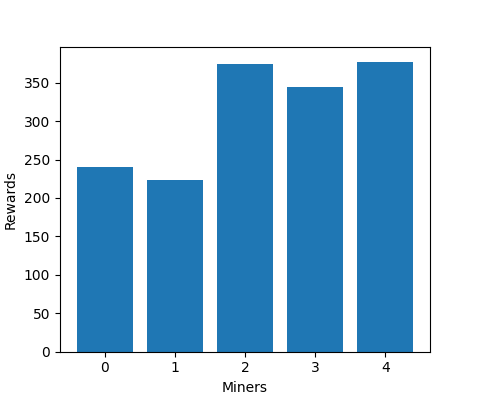Clone the repo and install the required packages:
git clone https://github.com/oneskovic/cocp_simulations.git
cd cocp_simulations
pip install -r requirements.txt
import numpy as np
import matplotlib.pyplot as plt
from simulate_strategy import MiningSimulator
miner_cnt = 5
simulator = MiningSimulator(
problem_cnt=100,
packet_size=5,
miner_compute_powers=np.full(miner_cnt, 10.0),
miner_thresholds_low=np.full(miner_cnt, 0.0),
miner_thresholds_high=np.full(miner_cnt, 2.0),
iterations=50
)
search_times, mine_times, rewards = simulator.run_simulation()
plt.bar(range(miner_cnt), rewards)
plt.xlabel('Miners')
plt.ylabel('Rewards')
plt.show()The simulator is a simple environment that simulates strategies of miners on the network as proposed in the proof of useful work paper.
The simulator is based on the following assumptions:
- Each miner follows this strategy:
- Decide which package treshold is acceptable
- Look for a package that fits the treshold
- Start mining the package
- Once someone finds a new block, stop mining, do not change tresholds, find a new package and repeat this process.
- Each miner has perfect knowledge of the problem difficulties (essentially difficulty estimation is perfect)
- Problem fee is a function of the difficulty and difficulty only
- Each miner finds packets with rate proportional to the miner's compute power
The parameters of the main MiningSimulator class are:
problem_cnt: The number of problems in the instance pool.packet_size: The number of problems in a packet.miner_compute_powers: A numpy array of size (number of miners) that contains the compute power of each miner (in difficulty/s).miner_thresholds_low: Left bound of the threshold interval for each miner. A numpy array of size (number of miners).miner_thresholds_high: Right bound of the threshold interval for each miner. A numpy array of size (number of miners).iterations: Number of iterations to run the simulation for.packet_creator: Packet creator class (checkPacketCreatorSimulatedinpacket_creation.pyfor the interface). Defaults toPacketCreatorSimulated.difficulty_generator: The function that generates the difficulties of the problems in the instance pool. Defaults toget_difficulties_pareto.
- Run difficulty generator and store in
self.problem_difficulties. These are the difficulties of problems currently in the "instance pool". - Compute remaining times (how much time each miner will need for each problem). This is a numpy array of shape (number of miners, number of problems). Store in
remaining_times.
The simulator performs the following steps the given number of times:
- For each miner find the packet that fits the threshold. Compute the time needed to find the packet.
- For each miner compute the time spent to mine the packet (the time that miner would need to create a block).
- Find the winner (miner that has the lowest time spent searching + time spent mining).
- Reward the winner as per the
get_feefunction. - Reset the difficulties of problems that were mined by the winner. Update
self.problem_difficulties. - Update the remaining times for all miners - although the other miners did not mine a block, they still solved some problems, or made progress. Update
remaining_times. - For each miner update the remaining times for the new problems that were generated instead of the mined problems. Update
remaining_times.
